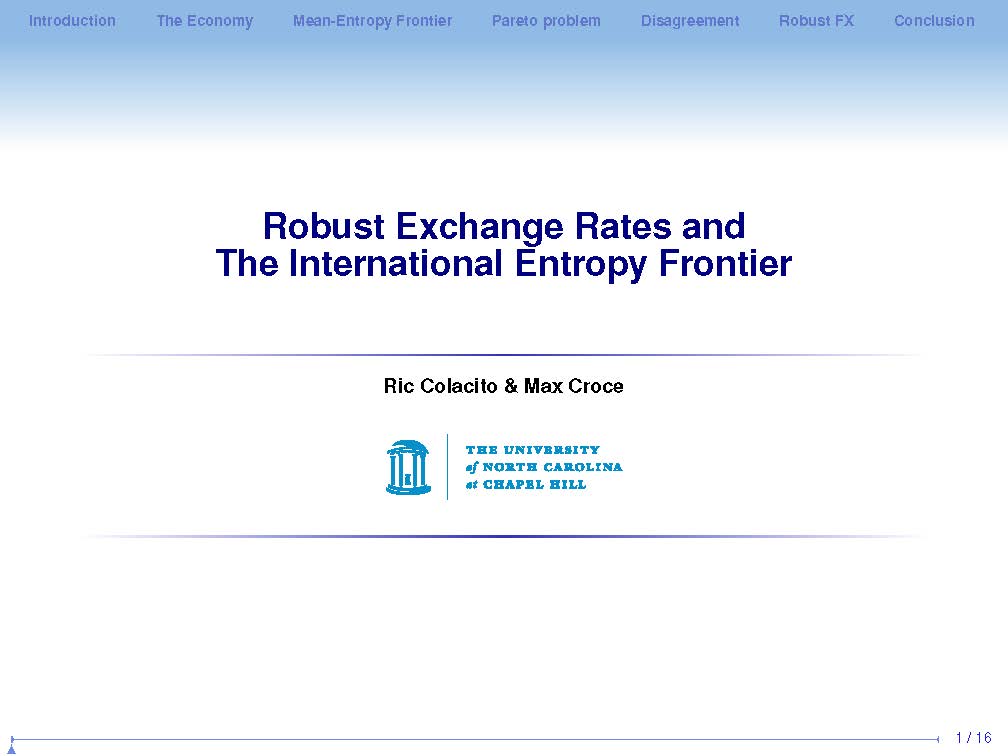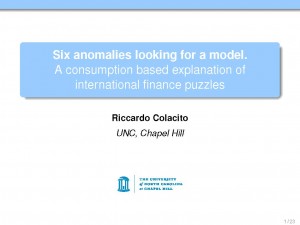International Climate News |
||
| We develop novel high-frequency indices that measure climate attention, covering a wide range of both developed and emerging economies. This is achieved by analyzing the text of nearly 24 million tweets published by leading national newspapers on Twitter during the period from 2014 to 2022. Our findings reveal that a country experiencing more severe climate news shocks tends to see both an inflow of capital and an appreciation of its currency. These outcomes align with the expectations of a risk-sharing model in which investors price climate news shocks, engage in the trade of both consumption and investment goods, and take into account the heterogeneity in the exposure to climate risk in the cross-section of countries. (with MaJo Arteaga-Garavito, Max Croce, and Biao Yang) Latest update: 1/2024 | 
|
 |
International Climate NewsSlides | SSRN | G-Scholar | YouTube | Website |
Volatility (Dis)Connect in International Markets |
||
| Lack of co-movement between consumption growth differentials and real exchange rates is a traditional indicator of a disconnect of foreign exchange markets from economic fundamentals (Backus-Smith 1993 anomaly). We present novel evidence for the (dis)connect between the volatilities, as opposed to the levels, of these variables. The volatility correlations are below one, but they are larger than the level correlations. In the cross-section of countries, the volatility disconnect weakens for countries with low amount of expected growth risk and high amount of volatility risk. We provide an explanation of our empirical findings based on international risk-sharing of both expected growth and volatility news shocks. (with Croce, Liu, and Shaliastovich) Latest update: 11/2023. | 
|
 |
Volatility (Dis)Connect in International MarketsSlides | SSRN | G-Scholar | YouTube |
Global sales, international currencies and the currency denomination of debt |
||
| We document that the currency of denomination of the debt of large firms in developed countries is strongly associated with the geographical distribution of their sales. Those firms also exhibit significant bias towards borrowing in their home currency and in international currencies (the US dollar and the euro). Debt currency choices are associated with export invoicing patterns, consistent with a currency hedging mechanism. In particular, firms in countries that invoice more in their home currency or in vehicle currencies display a weaker debt-sales link, and firms in countries invoicing more in international currencies exhibit stronger international currency bias when borrowing in global financial markets. (with Yan Qian and Andreas Stathopoulos) Latest update: 9/2023 | 
|
 |
Global sales, international currencies and the currency denomination of debtSlides | SSRN | G-Scholar | YouTube |
Robust Exchange Rates and the International Entropy Frontier |
||
In this study, we present a model of international risk-sharing. Our model operates within a frictionless general equilibrium setting, where two agents engage in trade. These consumers exhibit a preference for robustness and trade in two consumption goods along with a complete set of date- and state-contingent securities. The inclusion of consumption home bias and a focused concern on the temporal distribution of entropy contribute to the emergence of complex endogenous dynamics. These dynamics significantly affect the higher moments of both international prices and quantities, highlighting the intricate interactions between consumption preferences, risk-sharing mechanisms, and global market movements. This model sheds light on the nuanced ways in which global trade patterns and financial markets are influenced by underlying risk and preference structures. (with Max Croce). Latest draft: 2/2015. |

|
 |
Robust Exchange Rates and the International Entropy FrontierSlides |
Six Anomalies looking for a model |
||
| When the dynamics of consumption growth in two countries include small and highly persistent predictable components and agents display a preference for the timing of the resolution of uncertainty, it is possible to explain a large number of international finance puzzles. This includes the relatively small volatility of the growth rate of the US dollar, the high correlation of stock markets returns paired with a modest degree of co-movement of fundamentals and the low correlation between consumption growth differentials and the depreciation of the exchange rate. When stochastic volatility is also assumed to be a factor in accounting for the dynamics of consumption growth, then the forward premium anomaly can also be accounted for by the model. Latest draft: 11/2014. | 
|
 |
Six Anomalies looking for a modelSlides | SSRN | G-Scholar |
On the Existence of the Exchange Rate When Agents Have Complete Home Bias and Non-Time Separable Preferences |
||
| Colacito and Croce (2006) study the dynamics of the growth rate of the real exchange rate, when the preferences of the representative consumers in the two countries are defined only over the domestic good and characterized by non-time separability a la Epstein and Zin (1989). This paper shows that an equilibrium of this economy exists in which exchange rates are well defined and it can be interpreted as the limiting case of an economy in which preferences are defined over both domestic and foreign goods. Latest draft: 1/2009. |
|
On the Existence of the Exchange Rate When Agents Have Complete Home Bias and Non-Time Separable PreferencesSSRN | G-Scholar |